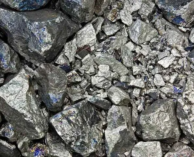Gallium’s Strategic Importance Grows Amid Global Supply Concerns

Gallium, a rare earth metal critical to electronics manufacturing, has become a focal point in global supply chain discussions due to its unique properties and strategic applications. Its electrochemical characteristics make it indispensable for producing LEDs, semiconductors, and specialized components used across the tech industry, aerospace, defense, and other strategic sectors.
Gallium is predominantly extracted as a by-product of aluminum refining and, to a lesser extent, from zinc ores. Global production has grown from a few tons in the 1970s to 450 tons annually in 2024. Despite its small market—valued at $25 million in 2023—gallium demand is expected to grow at a 7% CAGR through 2030, driven by its applications in integrated circuits and optoelectronics.
Gallium's significance has intensified amid the U.S.-China trade war. In 2023, China, which controls 98.8% of global gallium supply, imposed export restrictions, leading to a 13-year price high. These sanctions threaten Western semiconductor manufacturers dependent on gallium, further escalating tensions in global technology supply chains.
Key applications of gallium include gallium arsenide and gallium nitride for semiconductors, LEDs, laser technologies, and renewable energy systems. Gallium nitride is crucial for advanced lighting, autonomous vehicle sensors, and aerospace electronics due to its radiation tolerance. Additionally, gallium-based materials are gaining traction in medical imaging, cancer therapies, and antibacterial treatments.
China's dominance stems from mandated gallium recovery in aluminum production, leading to a long-standing global oversupply and weakened competition. This strategic control has left Western nations vulnerable, with the U.S. Geological Survey estimating that gallium export restrictions could cost the U.S. up to $3.1 billion.
Efforts to diversify supply include initiatives by Rio Tinto in Canada, Metlen Energy & Metals in Greece, and Nyrstar's planned $150 million recovery facility in Tennessee. However, Western producers seek long-term government and industry commitments before investing in costly production upgrades.





